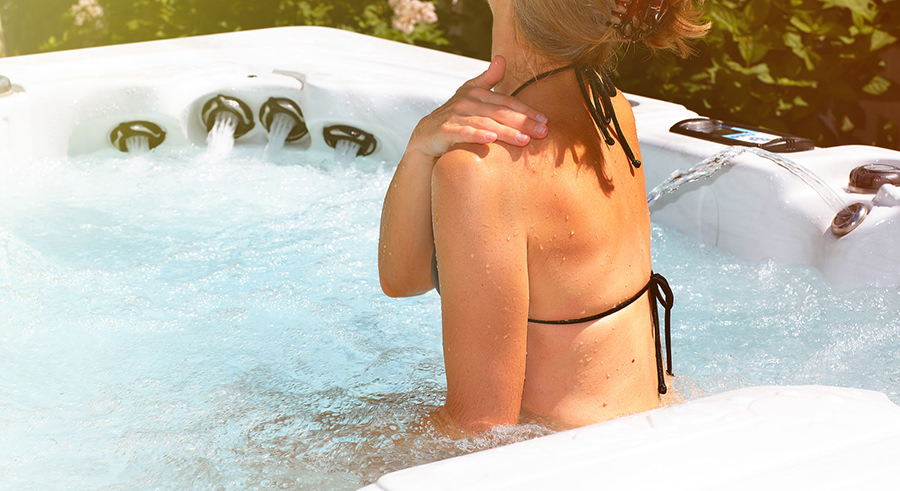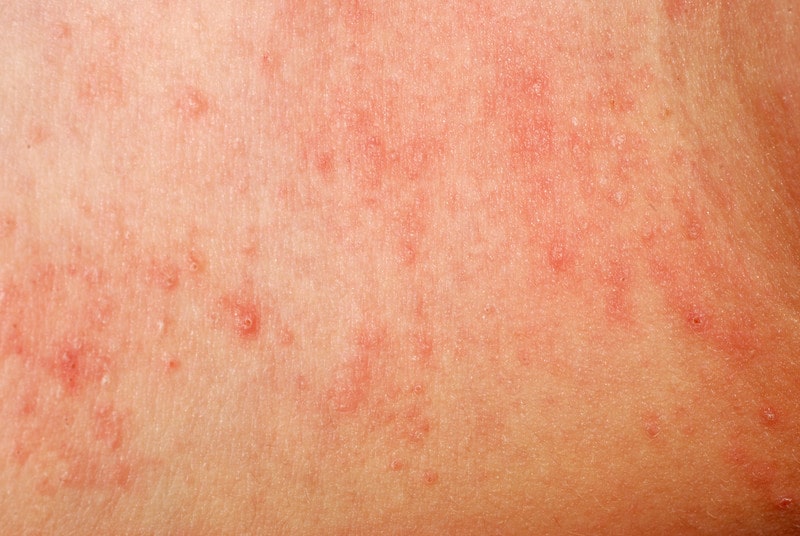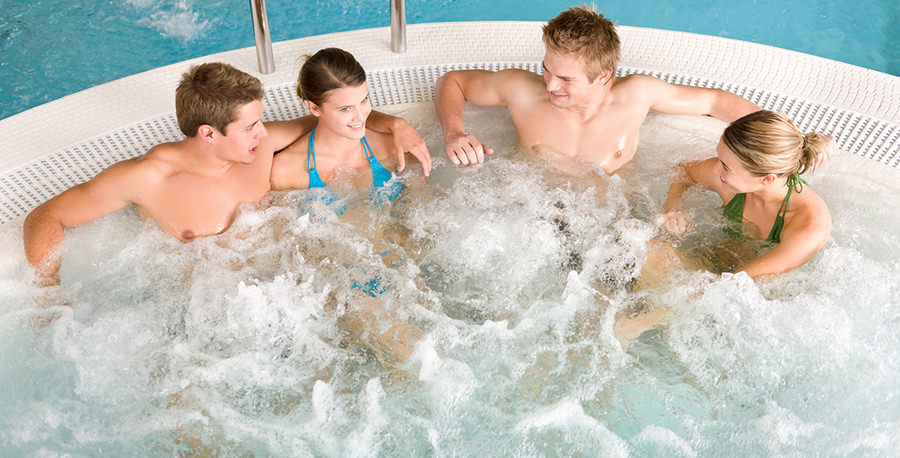
Had you ever considered that your hot tub could make you sick? Maybe you have read about the number of illnesses that it’s potentially possible to pick up from a hot tub or you know of someone who became unwell after using a hot tub. As with many things, there is a lot of sensational reporting of such issues and it can sometimes become difficult to separate the fact from the fiction.
So, can a hot tub make you sick? If the hot tub is well maintained the chances of it making you sick are remote. In poorly maintained hot tubs there is a chance of catching legionnaire’s disease and also other germs can thrive. It’s also possible to get a hot tub rash either due to an
So, what are the most common illnesses that you can get from using a hot tub and what causes them?
Legionnaires Disease
Legionnaires disease seems to have had a lot of coverage in the press recently and is quite a well-known disease. In fact, in 2016 6100, people are hospitalized in the United States with it. It can be very unpleasant, and has symptoms including severe pneumonia type problems as well as secondary symptoms that are similar to a really bad dose o
Legionnaire’s disease is treatable with antibiotics and is not usually a very serious problem in healthy people. However, people with respiratory problems, heavy smokers, the elderly and people with a reduced immune system are at risk of becoming seriously ill if they contract it. Around 10% of people who contract the disease will die from it.

So, how does Legionnaire’s Disease get into a hot tub?
Basically, Legionella is a waterborne bacteria
The message is to keep on top of your water chemistry and sanitization. Check the water regularly and, if in any doubt drain the hot tub and start again with clean fresh water.
Hot tub lung
Hot tub lung thankfully is very rare. Apparently, only about 70 cases have ever been recorded but if you are unlucky enough to get it the symptoms can be quite unpleasant. In a similar way to Legionnaires disease above, if you contract hot tub lung you will get flu-like symptoms including
Hot tub lung is caused by another type of bacteria which thrives in hot damp atmospheres. The bacteria is called Mycobacterium

If you do breathe it in the bacteria can cause small patches of inflammation in the lungs which causes the problems. It seems that it’s most likely that you will catch hot tub lung if you frequently use a hot tub in a poorly ventilated area. There’s a greater risk of getting it if you are using an indoor hot tub for example. Generally speaking, the condition clears up quite easily in fit and healthy people if you stop using the hot tub or at least stop using the hot tub inside. More serious cases might need treatment with antibiotics or corticosteroids.

Hot tub skin rashes
Getting a skin rash after frequent use of your hot tub is actually quite a common occurrence. A number of people have what they would call sensitive skin and the atmosphere of the hot tub can frequently cause increased irritation for a number of reasons. Whilst most people will just assume that there is only one type of
Rashes caused by chemicals – this one sounds more worrying than it actually is. Essentially this is an irritation to the skin caused by the chemicals in the hot tub. When you’re in the hot tub the hot water can deplete your skin of his natural moisture and defense mechanisms. The sanitizers in the water, chlorine or bromine, also make this skin dryness worse and this can lead to irritating itchy spots redness and bumps. In many
It’s also possible of course that you could be allergic to one of the chemicals in the water in your hot tub. One particular chemical called Potassium Peroxymonosulfate has been found to be particularly linked with allergic reactions. It’s used to eliminate organic contamination so you might find it in shock treatments for example. If you are having what do you think is an allergic reaction to your hot tub then check to see if this chemical is used in any of the water treatment products you are using.

Folliculitis skin rash – Folliculitis is a little bit more serious than getting a chemical rash. The symptoms can be more irritating and painful and a little longer to both develop and retreat. Folliculitis is a bacterial condition caused by the bacteria that
Hot hand/foot syndrome – This rather unpleasant sounding condition is caused by the same bacteria as above. It can cause fevers and also skin rashes and blisters on the hands and feet. In more extreme conditions this can lead to extreme pain when walking.
The key to not getting any form of hot tub skin rash is to make sure, as usual, that the hot tub is properly sanitized so that the bacteria can’t develop in the first place. It’s also a really good idea to shower as soon as you get out of the hot tub and to wash swimwear as well. Most minor hot tub rashes will clear up on their own in a few days but, if you suspect that you have
UTI
It’s extremely unlikely that you will contract a urinary tract infection from using a hot tub. However, there have been a few isolated cases where people
I read about a piece of research in the 1980s were the scientists assumed that the only reason that the
Were they not wearing swimwear?
Talking of which there’s another single study which took place in 2009 where a man developed a very serious life-threatening condition after being in a hot tub where are the bacteria that causes the UTI actually found that his way into his bloodstream. He later admitted to having sex with his wife in the hot tub and the scientists assumed that the bacteria had entered his urethra during intercourse!
So, you are extremely unlikely to contract a urinary tract infection in a hot tub. There is yet another study which took place in 2000 which stated that using hot tubs is not a risk factor among young women who had recurrent UTIs at all.

Diarrhea/cryptosporidium
Cryptosporidium or crypto for short is a particularly nasty little parasite that spreads through swallowing infected water. It usually gets in the water through fecal matter and it’s even resistant to chlorine and bromine so can quite happily live in your hot tub.
It’s also worth noting here that in every single hot tub and swimming pool there is a measurable amount of fecal matter floating around in the water. In
So the big takeaway here is to not swallow water from your hot tub! If you do, and you’re unlucky enough to be struck down by the crypto parasite then you will get the familiar symptoms of diarrhea – stomach ache, fever nausea
Seizures
In very rare cases using a hot tub has been linked to epileptic seizures. This is known as reflex epilepsy and is where the seizures are caused by environmental stimuli such as smells, lights, noise and sudden changes of temperature. Apparently, this type of epilepsy is more common in children where the sudden change from going into hot water can cause a seizure. If you know that you are prone to epilepsy seizures then it makes good sense to speak to your doctor or specialist before using a hot tub.
Ringworm
Ringworm is highly contagious and it thrives in warm moist areas. You usually get it by direct skin to skin contact but it can actually be contracted via unwashed clothing, wet surfaces or anywhere that is moist and damp. So yes, it is possible to catch ringworm from using a hot tub

Some common conditions that you cannot get from being in a hot tub
Can I get pregnant from a hot tub?
It’s highly unlikely that any sperm floating around in a hot tub would survive for any more than a few moments. In
However, if you have sex in a hot tub there is every possibility that you may become pregnant. Technically speaking the chances of the sperm surviving, or being in the best condition is relatively low due to the high temperatures of the water. However, assuming that the sperm didn’t directly come into contact with the water then it would certainly be possible to get pregnant after having sex in a hot tub
Can I catch an STD in a hot tub?
There are no documented cases of anybody getting a sexually transmitted disease from being in a hot tub. STDs are transmitted during sexual intercourse and through skin to skin contact, STDs are not transmitted through water. You cannot contract and STD from being in a hot tub.
If you indulged in intimate skin to skin contact or sexual intercourse in a hot tub then, of course, you should take the normal precautions to prevent the transmission of STDs. H
Can I catch Herpes in a hot tub?
Herpes is a virus that’s transmitted through sexual activity or via infected fluids through open skin wounds. It is extremely unlikely that you will be infected with the herpes virus just by sharing a hot tub with a herpes carrier. The chlorine and sanitizing chemicals found in hot tubs and swimming pools are also very effective at killing the virus germs.
Can I get a yeast infection from using a hot tub?
You cannot catch a yeast infection from being in a hot tub, it can only be passed through sexual contact and even then the risk of infection is extremely low. If you have a yeast infection it’s perfectly fine to use the hot tub but just remember that the yeast is basically a fungus and so thrives in warm moist conditions. When you get out of the hot tub it’s important to dry the vaginal area thoroughly and to change out of wet swimming suits as quickly as possible. You may also want to limit your use of the hot tub to reduce the chances of a yeast infection developing.
Can I catch Chlamydia in a hot tub?
Can I get Scabies from using a hot tub?
Scabies is caused by tiny mites that burrow into the skin causing severe itching and irritation. This becomes worse if the area where the mites are borrowing becomes infected. It’s highly unlikely that you will contract scabies from a hot tub as it’s usually associated with being passed by prolonged skin to skin contact. Again it’s commonly transmitted during sexual intercourse but it’s also possible to pick it up by sharing articles such as clothing, towels or bedding.

How to make sure your hot tub doesn’t make you ill
Having read about all of the illnesses that you can contract from your hot tub you’re possibly feeling a little bit worried about going back in it! It’s worth bearing in mind that the chances of contracting
So how do you make sure that your hot tub is healthy?
Basically, it’s all down to cleanliness and water management. If you follow the tips below then you shouldn’t have any problems.
Check the ph level of the water – First of all, sanitizers and other cleaning chemicals won’t work properly if the ph level of the water is incorrect. You need to regularly check that the pH level is ok and correct it with chemical balancers if not. This is a simple case of using test strips and adding the appropriate chemical and only takes a few moments to do.
Check your sanitizers – It’s also important that you do a regular weekly check of your sanitizer level. You will probably be using either chlorine or bromine and it’s important that the levels of each of these chemicals are correct in the water. Your sanitizer is your main defense against bacteria growth so it has to be consistently kept at the right level. Again, check with a test strip and add
Shock treatments – If your hot tub has undergone a period of very heavy use then the sanitizer may well need a boost. This is called shocking the hot tub and you need to do it on a regular basis to make sure that the level of
Change the water regularly – Most hot tub manufacturers recommend completely draining and changing the water in your hot tub every 3 to 4 months. This is vital if you are to keep the water in good condition as, once you get to a certain point, no amount of chemicals will keep the water clean and healthy. You can check whether your water needs to be drained and changed by measuring the total dissolved solids in the water. The level should be no more than around 1500 parts per million. You will also know that your water needs changing if it is cloudy, excessively foamy or smelly.
Flush and clean your hot tub – When you do drain your hot tub it’s important to use a flushing solution just before you completely drain it. This will flush out and clean all the internal mechanisms of the hot tub and help prevent bacteria forming. Once the hot tub is empty it’s important to give it a thorough clean to make sure that there is no algae growth, no staining and no dirt in the hot tub.
Use a cover – Apart from keeping your water chemistry correct it’s important that you prevent as much dirt as you can from entering the hot tub. Use a well fitting good quality cover and make sure that when the hot tub isn’t in use the cover is in place. N
Shower before and after – It’s a very good idea to shower in plain water both before and after using the hot tub. If you do this beforehand it will go some way to removing the soaps, moisturizers, shampoos
Do not swallow
Wash your swimsuit – Another good idea is to wash your swimsuit after each use in the hot tub. After you have used it let it dry in a well-ventilated place and rinse it out or wash it as soon as possible. This will prevent unwanted bacteria from developing and potentially being transmitted to your body.

Cleanliness in hotel/spa hot tubs
You can obviously control the cleanliness of your own hot tub at home
So how can you tell if a public hot tub is clean?
Use your nose – You can also tell a lot about the cleanliness of a hot tub by the smell. If there is an unpleasant smell coming from the water then the chances are that it isn’t clean. If there’s a strong chlorine smell coming from the water, contrary to what you might believe, this can also indicate that the water isn’t particularly clean as well. Chlorine creates a strong smell when it is fighting hard to remove organic matter from water. This can mean that the chlorine has less power left over to fight bacteria and germs so be aware.
Ask about the maintenance schedule – There’s no reason why you can’t ask the staff at the hotel or spa about the hot tubs maintenance schedule. In
Use test strips – You could also go as far as testing the water yourself. Test strips are cheap to buy and quick and inconspicuous to use. You should find that the chlorine level Is between 2 and 4 parts per million, bromine level between 4 to 6 parts per million and the pH level between 7.2 and 7.8. If you are not happy that the test strip is indicating the correct levels then speak to the maintenance staff and avoid going into the water.
Shower thoroughly – Even if you are happy that the water is clean it’s a very good idea to have a thorough shower after being in a public hot tub. If you have managed to pick up any germs or bacteria this will go a long way to removing them and
Summary
The chances of you actually contracting an illness from a hot tub are relatively remote. If you keep your hot tub’s water in good condition and shower before and after use and avoid drinking the water then it’s extremely unlikely that you will have any problems.
However, if you are using a public hot tub then the issue becomes a little more complicated. The hot tub is probably heavily used and you don’t know the state of cleanliness of the people who have been in it. Also, most importantly, you don’t have control over the chemical cleanliness of the water either. In theory at least the water should be professionally maintained and there shouldn’t be any problem but use your common sense and the checks above and avoid using any public hot tub that you aren’t completely happy with.

